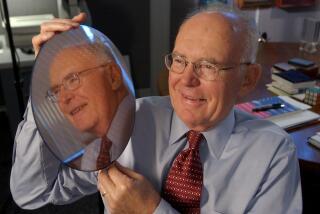A Young Computer Firm With a Chip on Its Shoulder : Technology: Cyrix Corp. takes on giant Intel over its microchip designs with retaliatory antitrust lawsuits.
- Share via
RICHARDSON, Tex. — At times it seems a toss-up whether the people at Cyrix Corp. spend more time on litigation or on the design of advanced computer chips. Both jobs are crucial to the cheeky young firm’s efforts to shove aside the huge company that practically invented the world’s $58-billion-a-year microchip industry.
At Cyrix’s two-story headquarters in this Dallas suburb, engineers work at computer screens to design chips that crowd hundreds of thousands of transistors into fingernail-size slivers of silicon. But often the work is interrupted when a key person disappears for a daylong deposition.
“They’re a big company and they’re trying to bully us,” said Nancy Dechaud, a senior chip designer at Cyrix. “Why don’t they just let us compete?”
“They” is Intel Corp. of Santa Clara., Calif., a $6-billion-a-year operation that is credited with key inventions of the microelectronics age: the memory chip and the microprocessor. Intel contends that Cyrix’s chips are illegal rip-offs of pioneering Intel designs and has filed two patent infringement suits.
“We spend money to develop our assets,” said Andrew Grove, Intel’s chief executive. “We will protect them. There are laws in this country.”
Cyrix has countered with an antitrust suit accusing Intel of trying to throttle competition. Now 5 years old, Cyrix spends more on lawyers each year than its original $4 million of start-up capital.
While the suits sputter along, Cyrix has won important respect.
“They clearly have shown product ingenuity and quick design capability,” said Dan Klesken, who watches the semiconductor industry for the securities firm Robertson, Stephens & Co. of San Francisco. And they are doing it, he said, “with resources that are a fraction of Intel’s.”
Cyrix does not deny its products mimic Intel’s in function. Indeed, that was the goal from Day One: to create chips that would seem just like Intel’s when plugged into a circuit board. But Cyrix contends that it has developed independent designs that achieve these functions, rather than stealing Intel’s designs. That would put Cyrix on the right side of the law.
Still, many outsiders say Cyrix’s task is fundamentally easier than Intel’s. Klesken compares Intel to the first pioneers who crossed the Rocky Mountains. With the trail established, the followers traveled much faster.
Cyrix specializes in the microprocessor, the “computer on a chip” that controls the basic functions of a personal computer. Once a virtual preserve for Intel, the $4.7-billion world market for microprocessors has turned into a hive of competition in the last 18 months as Cyrix and other companies came out with the first Intel-compatible microprocessors. In some cases, they improve on Intel’s products.
Cyrix’s sales have grown to $75 million a year since it was founded in 1987 in rented space by Jerry Rogers and Tom Brightman, two engineers who had left Texas Instruments Inc.
The Cyrix name has no particular meaning. But several of its financial backers had luck with other companies bearing two-syllable names beginning with the letter C--Compaq Computer Corp. and Cyprus Semiconductor Corp.
To date, Cyrix’s main inroads have been with obscure PC brands such as VIP, DFI and Twinhead. But it has taken on a few national names too, such as CompuAdd Computer Corp., and has expanded into Japan, selling more than 70,000 chips there.





